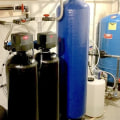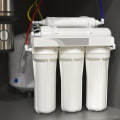Water filtration is an essential process for providing clean and safe drinking water. A standard reverse osmosis system is typically equipped with three distinct filter stages, each of which plays an important role in the overall filtration process. The sediment filter, carbon filter, and reverse osmosis membrane are the three main components of a multi-stage water filter system. The sediment filter is usually the first stage of a multi-stage water filter system.
It removes large particles of sand, silt, dirt, and other suspended solids from the water. This helps to protect the subsequent stages of filtration in a water filtration system, preventing early clogging of the environment and extending its useful life. Carbon filters, such as carbon block filters and granular activated carbon filters, are another common filtration step in a multi-stage water filter system. These filters use adsorption to extract contaminants such as chlorine from water.
Carbon filters are often combined with other filter media, such as KDF and ion exchange resin, to improve filtration and add a couple of additional filtration steps to a water filter system. The reverse osmosis membrane is the third stage of a multi-stage water filter system. It has small pores that block most contaminants larger than 0.0001 microns in tap water. This stage of the filtration process removes more contaminants than any other stage. Ultrafiltration membranes are generally combined with other filtration steps in multi-stage water filter systems.
A UF filter must be protected by at least one sediment pre-filter stage. A UV light is a common additional filtering step for whole-house well water filtration systems. This type of post-filter sends water through a UV chamber, where it is treated with ultraviolet light. Ultraviolet light breaks down the DNA of microorganisms such as bacteria and viruses, preventing them from reproducing or making them sick when you drink the water. Nowadays there are various models of reverse osmosis systems available on the market.
This can be explained by the number of steps used in a system. Below is a description of 3-stage and 5-stage reverse osmosis systems. In most cases, 3-stage reverse osmosis systems are used for large scale water purification. This can be done by aquarium managers who want to protect their fish from harmful chemicals or farmers who can use them in saline environments to reduce the amount of salt contained in the water for proper growth and maturation of seedlings. The polypropylene sediment filter is responsible for filtering all solid substances from water, mainly sediments. The carbon water filter is usually charged in most cases and contains a negative charge that attracts pollutants since they mostly have positive charges.
This causes them to be removed from the water and also eliminates the taste and smell of the water. The filter also removes tiny sediment particles (larger than 1 micron in size) that may have remained in the polypropylene sediment filter. As in the 3-stage reverse osmosis system, this system's carbon water afterfilter eliminates all remaining imperfections so that the water is ready for consumption. Nanofiltration requires less electrical energy and rejects less water (about 35%) than low RO (40-50%). Read about each stage of the filter to find a multi-stage water filter and decide if it's worth paying a little more for the system depending on your preferences and needs. Also, remember that many types of filters (including small water jug filters) combine multiple filtering steps in a single cartridge. If your space at the installation site is limited, opt for a smaller filtration system with fewer filter stages. Manufacturers often try to outperform their competitors with additional filter stages, so it's very common to see that the most expensive filtration systems combine seven, eight, nine, or even ten separate filter stages*.
After the purification process, the permeate tends to be slightly acidic (subject to the quality of the raw water) and is chemically tasteless. This is due to its ability to filter contaminants of all kinds and ensure the supply of high-quality drinking and cooking water. Make sure you know these two things when deciding on the right amount of water filter cartridges for you.


